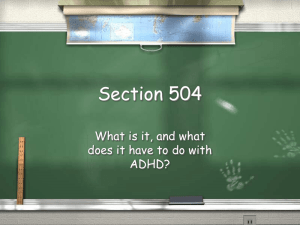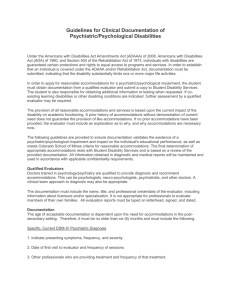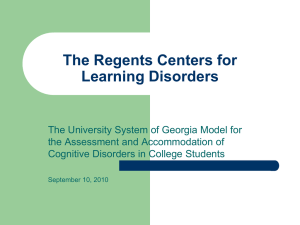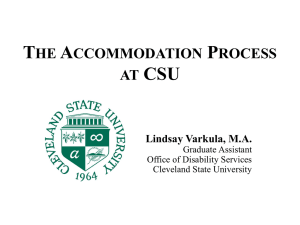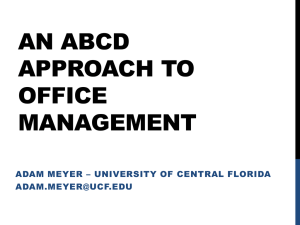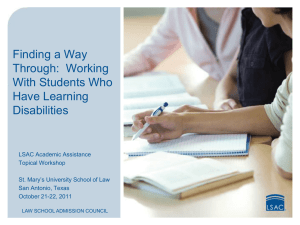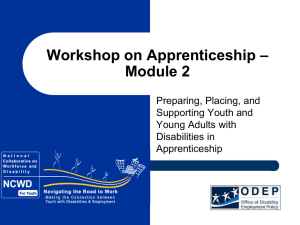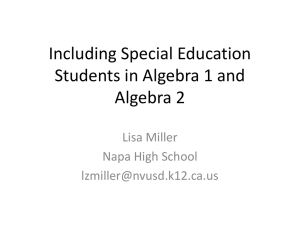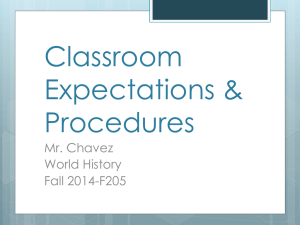Accommodating Students with Disabilities at BYU
advertisement
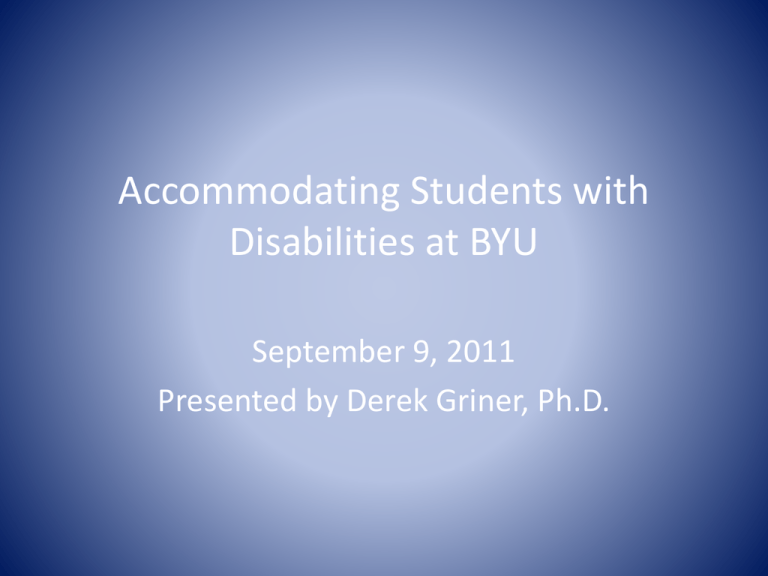
Accommodating Students with Disabilities at BYU September 9, 2011 Presented by Derek Griner, Ph.D. Activity Instructions • Please use your non-dominant hand to trace the letters on the page that you were given. • Work quickly and make sure that you follow the outline provided without going outside of the lines. • You will have a little over one minute to complete this task. Discussion • How was this experience? How is Someone Classified as Having a Disability? • Having a physical or mental impairment that substantially limits one or more of the major life activities of an individual. • Examples of major life activities listed in the Title I regulations include caring for oneself, performing manual tasks, walking, seeing, hearing, speaking, breathing, learning, and working. • Other examples of major life activities include sitting, standing, lifting, and mental and emotional processes such as thinking, concentrating, and interacting with others. What Constitutes “Substantially Limiting” • An impairment is substantially limiting if it prohibits or significantly restricts an individual's ability to perform a major life activity as compared to the ability of the average person in the general population to perform the same activity. • The determination of whether an impairment substantially limits a major life activity depends on the nature and severity of the impairment, the duration or expected duration of the impairment, and the permanent or long-term impact of the impairment. What Constitutes a “Mental Impairment?” • A “mental impairment” is generally held to be any recognized mental or psychological disorder that substantially limits one or more major life activities. • “Mental impairments” include learning disorders, ADHD, and emotional disorders (e.g., depression, anxiety, obsessive compulsive disorder, Aspergers Disorder, Autism, etc.). Once a Disability is Established… • Establishing that one has a disability is only one aspect of the analysis, as only a qualified individual with a disability is protected from discrimination under federal law. • A “qualified individual” is one who “with or without reasonable accommodation can perform the essential functions of the position” (whether it be as an employee or student). • So, if you one were so impaired that they could not complete a class or course of study even with reasonable accommodations, they probably would not be “qualified” under the law. The University Accessibility Center’s Mission • The University Accessibility Center seeks to provide all students with disabilities equal access to educational opportunities and to eliminate barriers which might impede participation in academic pursuits at BYU. Why Does the UAC Have This Mission? • BYU is bound by three major federal disability laws: 1) The Rehabilitation Act of 1973 (particularly Section 504) 2) The Americans with Disabilities Act (ADA) 3) The Americans with Disabilities Act – Amendments Act (ADAAA) BYU has to comply with these laws because we receive federal funds. These laws are civil rights laws and are enforced in part by the Office of Civil Rights (OCR) under the Department of Education. Student Statistics • Last academic year the UAC had around 928 student clients during Fall/Winter semesters. • These students fell into the following groups: Emotional Disorders ADHD Chronic Illness (fibromyalgia, Lyme's disease, etc.) Learning Disorders Physical Disabilities/Mobility Deaf/Hard of Hearing Visual Other (33%) (22%) (15%) (13%) (4%) (3%) (3%) (7%) Receiving Accommodations Through the UAC • In order for students to receive accommodations through the UAC, they must provide documentation of a disability. • When a student provides documentation of their disability, they can receive accommodations that are based on the functional limitations of the disability. • This documentation is also necessary to write letters supporting various student petitions (e.g., withdrawal from classes, reduced course load, etc.). • Evaluations can be conducted to assess for learning disorders, ADHD, psychological, and neuropsychological conditions. Documentation of Disability Form This is the form that the UAC provides students to be completed by their treating professional. Michael Adams has this form in an electronic format that may be easier for some. What is a Reasonable Accommodation? Generally defined as: • Modification or adjustment to the academic environment • A modification or adjustment that allows a student with a disability to enjoy the same benefits/privileges enjoyed by non-disabled individuals, as long as the modification does not: - pose an undue hardship on the institution or - fundamentally alter the class or course of study or - violate essential functions of the academic experience Accommodations Commonly Offered Through the UAC • • • • • • • • • • • • Additional time for exams/quizzes (1.5 or 2x time limit) Distraction reduced testing rooms (new at Testing Center) Peer note takers Copies of power-point presentations Audio recorded lectures Sign language interpreters Scribes for tests Computer-assisted exams (spelling and punctuation) Alternative exam format (e.g., oral testing, writing directly on exam, etc.) Exam and class breaks Providing alternative formats of printed materials (Braille books, mp3s of books) Course substitution Students are provided with letters to professors on their behalf outlining what accommodations are needed. Accommodations the UAC Provides Sparingly • Leniency with absences • Additional time for assignments • Flexibility with exam dates. • These accommodations are being provided with less frequency than they have been provided in the past for students struggling with emotional concerns. • The UAC has moved away from them because they tend to be iatrogenic in that students tend to fall further behind in class when these are used. Accommodations NOT Offered • Excusing the student from having to attend any classes • Videotaping classes or offering notes for time periods when student is absent • Excusing the student from exams • Mandating “Incomplete” grades • Substituting essential courses just because they are difficult Remember, accommodations are designed to offer equal access, not guaranteed success Things to Consider When Documenting a Disability • There must be a clear nexus between the accommodation requested and the functional limitation of the disability. • We can recommend accommodations, but it is important to remember that the UAC staff determines what accommodations will be provided. • Accommodations are provided on a case by case basis. Conclusion • Questions?

